Highlights
- Divorce is down, family stability for kids is ticking up, and the happiest men and women are married moms and dads. Post This
- Over the last decade, the divorce rate has fallen precipitously for less advantaged and black Americans. Post This
- Any marriage renaissance will be incomplete if it does not extend to adult men and women. At IFS, we are not sure about the trajectory of the institution for adults. Post This
For decades, conventional wisdom has held that the trajectory of American family life is heading in one direction: towards the abolition of marriage as the stable anchor of family life and a more diverse family future. In 1994, the family psychologist John Gottman wrote there is “no denying that this is a frightening time for couples” with “more than half of all first marriages [ending] in divorce.” A 2009 survey of contemporary family life authored by family scholars Elizabeth Peters and Claire Kamp Dush held that “Family forms are becoming increasingly diverse.” And in 2010, a Pew Research Center report heralded “The Decline of Marriage And Rise of New Families.”
To be sure, the idea that American family life was headed in a linear direction, away from marriage, seemed plausible at the turn of the century. The fortunes of marriage in America had been in freefall seemingly since the 1960s. In the immediate wake of the family revolution that took hold 60 years ago, divorce and single parenthood more than doubled, marriage rates plummeted, and diverse family forms surged. When these scholars weighed in, it was true that marriage’s hold over the bearing and rearing of children was heading for a nadir.
Given these trends, and the commentary that accompanied them, it’s not surprising that many Americans now believe marriage is in serious trouble. In fact, 88% of men and women think the divorce rate is increasing, as the 2019 American Family Survey found. And, looking to the future, a plurality of women and men are “pessimistic about the institution of marriage and the family,” according to a 2023 Pew survey.
But marriage is not dead yet. The family revolution that took hold in the second half of the twentieth century appears to be spent. If the institution of marriage is understood, fundamentally, as the vehicle for the bearing and rearing of children, there are promising signs that a “marriage renaissance,” to quote sociologist John Seel, may be in the offing. Culturally, books like The Two-Parent Privilege and Get Married, which underline the institution’s value for children, men, women, and the common good, are getting spotlighted in prominent mainstream media outlets like The Atlantic and The New York Times. This suggests the cultural elites who control the commanding heights of the culture are coming around to the idea that marriage matters.
Even more importantly, major shifts in family behavior are underway that indicate marriage is strengthening as the primary anchor of family life. Divorce is down, as is single parenthood, and the share of kids being raised in stable married families is ticking up.
Divorce is Down
The biggest shift relates to divorce. After peaking in the late 1970s and early 1980s, the divorce rate has been falling in recent decades. In fact, the divorce rate has hit a 50-year-low. Since the 1980s, each cohort of married couples has seen their risk of divorce decline, as the figure below indicates. For Baby Boomer couples marrying in the wake of the counterculture, the 1970s and 1980s, it looks like at least 50% of those couples will end up divorced. But as marriage has become more selective, with more educated, affluent, and religious couples becoming more likely to put a ring on it than the general population, marriage has been stabilizing in one cohort after another.
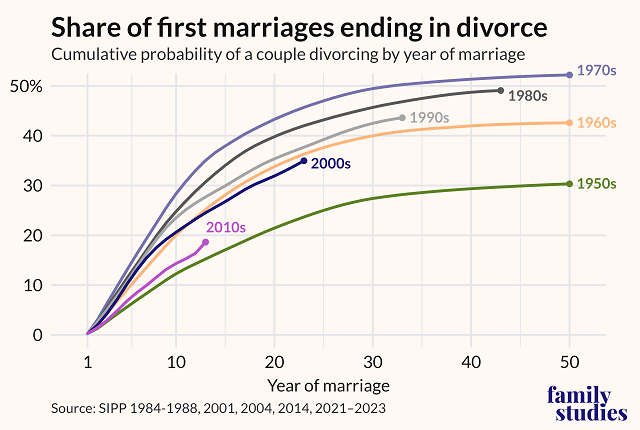
Certainly, because any couple’s risk of divorce is not eliminated until they die, we must be cautious in offering projections about divorce. In general, most divorces take place in the first 15 years of marriage, but if couples marrying in recent years end up seeing a large surge in gray divorce (when marriages break down for couples ages 50 and older), our estimates could be off.
Given these caveats, we estimate that for couples who first married in the 1990s, their risk of divorce looks to be about 47% over the course of marriage, whereas for those tied the knot in the 2000s, the risk has fallen to approximately 44 percent.1 If divorce rates from more recent years persist, we expect that 40% of couples marrying for the first time now will divorce. Our estimate is close to that offered by University of Virginia sociologist Yifeng Wan, who used a different methodology to project that about 42% of today’s couples marrying for the first time are likely to divorce.
The bottom line: Most married couples will make it.
Nonmarital Childbearing Has Leveled Off
Another key family trend, nonmarital childbearing, has also turned in a new direction. The trend, which had been rising on an almost year-over-year basis since the 1960s, peaked in 2009 at 41% (as the Great Recession took hold) before ticking down to about 40% a few years later, where it stands now. This matters for family stability because children born out of wedlock are significantly more likely to see their parents break up than children born to married parents.
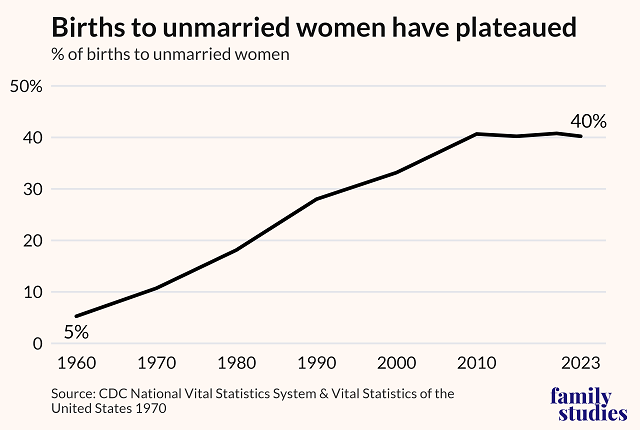
Share of Children in Married-Parent Families Ticking Up
Less divorce and a modest decline in childbearing outside of marriage equals more family stability for children and what looks like the end of the family revolution that began in the second half of the twentieth century. This is manifested, most clearly, in a reversal of the trend regarding children being raised in married-parent families. In 2012, according to the Current Population Survey (CPS), the share of kids raised in a married-parent family hit bottom at 64%. Since then, it has risen to 66 percent.
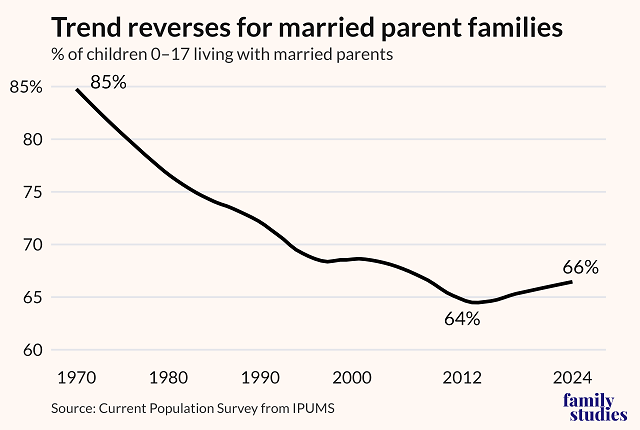
Likewise, the share of children being raised in a single-parent family has fallen 2 percentage points over the last decade, and the share in an intact, biological married family for the duration of their childhood has risen—specifically, from 51% in 2014 to 54% in 2024, according to the CPS. These reversals mean that marriage is back as the cornerstone of American family life. Stable marriage is increasingly the way that most men and women are raising children.
Black and Lower-Income Children More Likely to Live With Married Parents
But not everyone is benefiting equally from marriage’s comeback. Class and culture both shape who does and does not marry today—with educated, affluent, religious, and conservative Americans the most likely to put a ring on it. For instance, a majority of children (87%) from upper-income families have married parents, compared to a minority from lower-income families (42%).
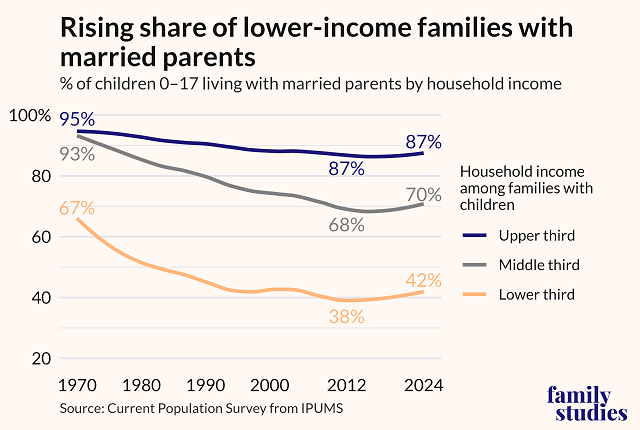
But even for groups where marriage lost the most ground in the second half of the twentieth century, the nation is witnessing signs of a marriage renaissance. Over the last decade, the divorce rate has fallen precipitously for less advantaged and black Americans. Largely as a consequence, the share of children in lower-income and black families with married parents has also ticked up.
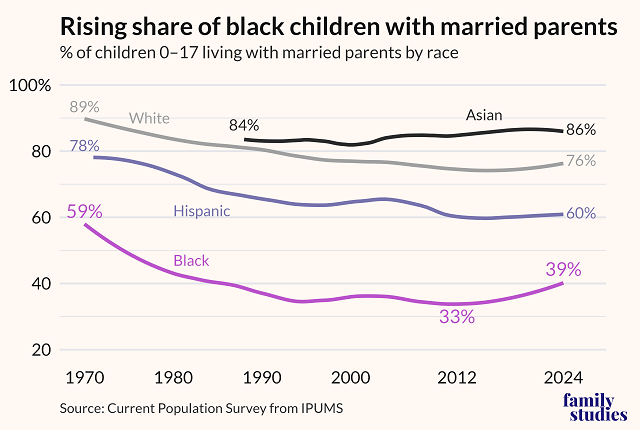
The percent of children in lower-income families with married parents rose from 38% in 2012 to 42% in 2024, even as the share of black children in such families rose from 33% to 39% in 2024. This increase in family stability among lower-income and black Americans is especially noteworthy because the nation’s retreat from marriage has been most consequential for these two groups since the 1960s.
Share of Men and Women Who Are Married Has Leveled Off
The upswing in marriage’s fortunes, however, seems limited to children and families. For adult men and women, the story is not as positive. The Institute for Family Studies estimates that record shares of today’s young adults—about 1-in-3—will never marry and never have children—about 1-in 4. Indeed, one reason that marriage and families are stabilizing in the United States is that family formation has become more selective for the kinds of men and women who have the economic resources and cultural commitments to succeed at family life. But this also means that historic levels of young men and women are not likely to go on to form families.

When it comes to adults, we detect no increase in the share of prime-aged men and women (25-55) who are married. While the marriage rate has rebounded since COVID, the share of adults aged 25-55 who are married is holding steady. It is not clear to us if marriage trends for adult men and women have reached a nadir or will begin falling again in short order. But the data suggest that any marriage comeback does not yet extend to adults.
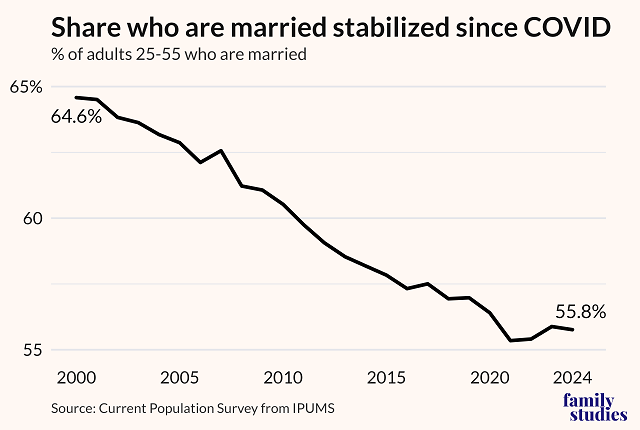
Is America’s “Keystone Institution” Coming Back?
As the primary institution for grounding and guiding family life for children, it looks like marriage is back. This is good news—both because the Americans who report the most meaningful and happiest lives are married mothers and fathers, and because the best social science tells us that children are more likely to thrive when they are raised by their own stably married parents. It is also good news because, as the Harvard anthropologist Joseph Henrich has noted, “marriage represents the keystone institution for most—though not all—societies and may be the most primeval of human institutions.” As our keystone institution, marriage plays a signal role in stabilizing family life, binding men to their children, endowing men and women’s lives with meaning and purpose, promoting prosperity, and ensuring social order.
But any marriage renaissance will be incomplete if it does not extend to adult men and women. At IFS, we are not sure about the trajectory of the institution for adults. On the one hand, political polarization between the sexes, the falling fortunes of men, and the digital revolution’s degradation of social skills and dating opportunities among young adults leave us worried about the future fortunes of marriage. On the other hand, growing cultural recognition of marriage’s value, recent religious and civic initiatives to promote marriage—like the ecumenical marriage ministry, Communio—and new nationwide efforts to protect children, young adults, and families from the addictive power of Big Tech could create a beachhead for civic, social, and cultural efforts to renew the fortunes of love, marriage, and family among the rising generation. Only time will tell if America’s keystone institution is headed for a comeback that extends not just to children but also to adult men and women across the nation.
Brad Wilcox is Distinguished University Professor of Sociology at the University of Virginia, Senior Fellow at the Institute for Family Studies, and nonresident Senior Fellow at the American Enterprise Institute. Grant Bailey is Research Associate at the Institute for Family Studies. Lyman Stone is Senior Fellow and Director of the Pronatalism Initiative at the Institute for Family Studies. Wendy Wang is Director of Research at the Institute for Family Studies.
1. Lifetime divorce risk is estimated by the cumulative probability of divorce through 50 years of marriage. Divorce risk after 50 years is negligible.









